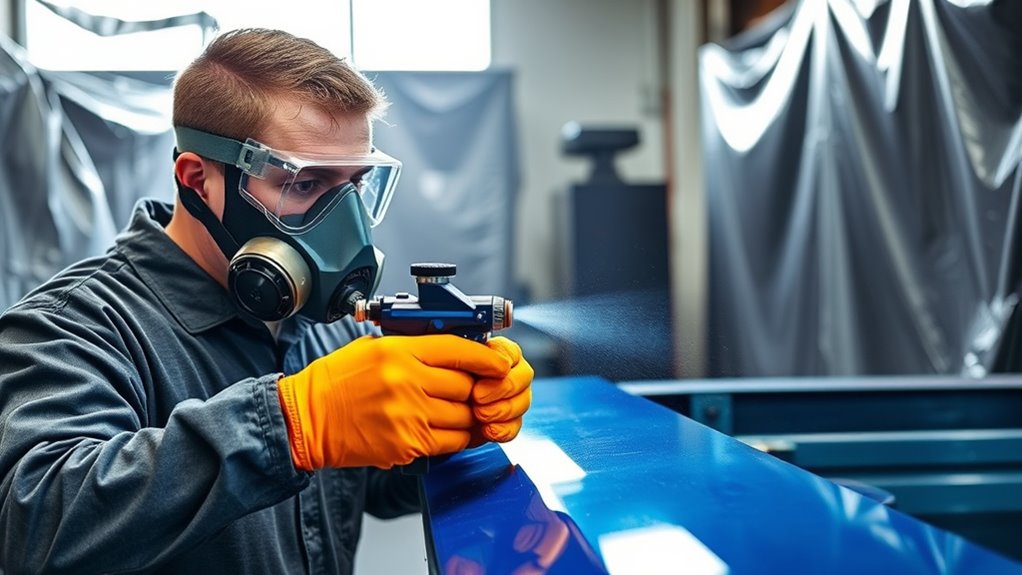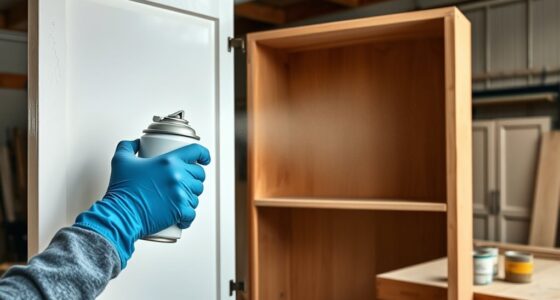To spray epoxy paints safely, always wear proper protective gear such as a respirator rated for VOCs, goggles, gloves, and a long-sleeved coverall. Make certain your workspace is well-ventilated by opening windows, using exhaust fans, or spraying outdoors. Follow the manufacturer’s instructions closely, and keep all safety measures in place until fumes dissipate. Taking these precautions helps protect your health—continue for more tips on a safe and effective epoxy painting process.
Key Takeaways
- Always wear appropriate protective gear, including respirators, gloves, goggles, and coveralls, during spraying.
- Ensure proper ventilation by working outdoors or using exhaust fans and air purifiers to disperse fumes.
- Follow manufacturer instructions precisely and keep protective gear on until fumes fully dissipate.
- Use local exhaust ventilation directly at the spray area to minimize inhalation risks.
- Safely dispose of leftover materials and cleaning supplies according to local environmental regulations.

Spraying epoxy paints can be highly effective for achieving a durable, professional finish, but safety should always come first. When working with epoxy paints, you need to prioritize your protection to prevent health issues caused by fumes and skin contact. Always wear the appropriate protective gear, including a respirator rated for volatile organic compounds, chemical-resistant gloves, goggles, and a long-sleeved coverall. These items serve as your first line of defense against harmful vapors and splashes, reducing the risk of inhalation or skin irritation. Remember, epoxy paints contain strong solvents that release fumes, which can be dangerous if inhaled in unventilated spaces.
Always wear protective gear and ensure proper ventilation when spraying epoxy paints for safety.
In addition to protective gear, guaranteeing proper ventilation is essential. Before you start spraying, set up a reliable ventilation system to channel fumes away from your workspace. If you’re working indoors, open windows and doors, and consider using exhaust fans or industrial-grade air purifiers designed to capture chemical vapors. For more extensive projects, it might be necessary to rent or install temporary ventilation systems that provide continuous airflow, pulling contaminated air out of the area and replacing it with fresh air. Proper ventilation not only safeguards your lungs but also helps your epoxy dry more evenly, reducing the risk of bubbles or uneven coating.
Never underestimate the importance of working in a well-ventilated environment. Poor airflow can cause fumes to linger, increasing the risk of headaches, dizziness, or long-term health effects. Make sure your ventilation system is functioning correctly before you begin spraying. Also, consider working outdoors or in a dedicated spray booth if possible, as these environments naturally provide better airflow and reduce the concentration of hazardous fumes. If you’re working indoors and can’t open windows, use local exhaust ventilation directly at the spray area to capture vapors at their source.
Always follow the manufacturer’s instructions on the epoxy paint can, especially regarding safety precautions. Keep your protective gear on throughout the spraying process and until the fumes have dissipated. After completing your project, dispose of any leftover materials and cleaning rags safely, following local regulations. Proper ventilation combined with the right protective gear minimizes health risks and ensures a safer, more effective epoxy spraying process. Your health and safety should always be your top priority when working with chemical paints.
Frequently Asked Questions
Can Epoxy Paint Fumes Cause Long-Term Health Issues?
Epoxy paint fumes can indeed cause long-term health issues due to epoxy toxicity from prolonged fume exposure. Breathing in these fumes may lead to respiratory problems, skin irritation, and even neurological effects over time. To protect yourself, guarantee proper ventilation and wear protective gear. Limiting exposure minimizes health risks, so always follow safety guidelines when working with epoxy paints. Your health depends on taking these precautions seriously.
What Should I Do if Epoxy Paint Gets on My Skin?
If epoxy paint gets on your skin, act quickly to protect yourself. Immediately remove contaminated clothing and wash the affected area with soap and water to prevent skin irritation. Use skin protection, like gloves, to minimize contact in the future. For first aid, apply a gentle moisturizer if needed, and seek medical attention if irritation persists or if epoxy penetrates the skin deeply. Quick action keeps you safe and healthy.
How Do I Store Leftover Epoxy Paint Safely?
To store leftover epoxy paint safely, make sure you tightly seal the container to prevent spills and evaporation. Store it in a cool, dry, well-ventilated area away from heat sources or flames. For storage safety, label the container clearly and keep it out of reach of children and pets. When disposing of leftover epoxy, follow local regulations for hazardous waste and never pour it down the drain to avoid environmental contamination.
Is It Safe to Spray Epoxy Paint Indoors?
It’s a risky move to spray epoxy paint indoors without proper precautions. You should always prioritize indoor ventilation to clear out fumes and wear protective clothing to shield your skin. Think of it like walking a tightrope—you need balance and safety measures in place. If you follow these steps, you can reduce health hazards and ensure a safer environment while working indoors. Always prioritize safety over convenience.
What Personal Protective Equipment Is Essential for Spraying Epoxy Paint?
You should wear a properly fitting respirator to protect your lungs from harmful fumes and dust. Make certain your respirator has a good seal and is rated for chemical vapors. Additionally, don protective clothing, including gloves and coveralls, to prevent skin contact with epoxy. Always check your respirator fit before starting, and use protective clothing to minimize exposure, keeping yourself safe during the spraying process.
Conclusion
Remember, safety always comes first when spraying epoxy paints. Wear your protective gear and guarantee proper ventilation to keep yourself safe from harmful fumes. Did you know that epoxy paints contain volatile organic compounds (VOCs) that can cause health issues if inhaled? By following these safety tips, you not only protect yourself but also achieve a smooth, professional finish. Stay cautious, spray responsibly, and enjoy the satisfying results of your work!
Franz came aboard the Paint Sprayer Zone team with a background in both journalism and home renovation. His articulate writing style, combined with a passion for DIY projects, makes him an invaluable asset. Franz has a knack for breaking down technical jargon into easy-to-understand content, ensuring that even the most novice of readers can grasp the complexities of paint sprayers.










